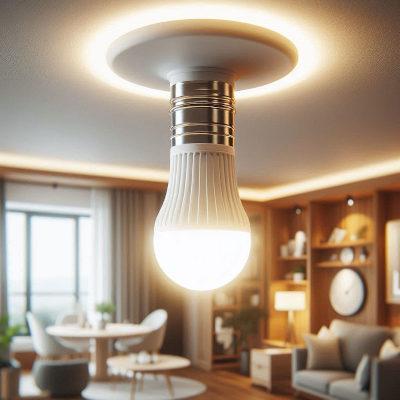Illuminating the Impossible: Overcoming Challenges to Create the Blue LED
Visible LEDs
The development of the first visible LED (Light Emitting Diode) is attributed to Nick Holonyak, Jr. He created the first practical visible-spectrum (red) LED in 1962 while working at General Electric.
Nick Holonyak, Jr.'s invention marked a significant milestone in the history of LED technology, as it demonstrated that LEDs could emit light in the visible spectrum, leading to the development of LEDs in other colors and eventually to their widespread use in various applications. Holonyak is often referred to as the "father of the light-emitting diode" for his pioneering work in this field.
But, blue LED was missing
Without blue LEDs, it was challenging to create white light efficiently using LEDs alone. Red and green LEDs existed, but without blue, full-spectrum white light production was impractical. This limited the potential applications and market demand for LEDs in general lighting and displays.
The creation of blue LEDs posed significant challenges compared to red and green LEDs, primarily due to limitations in semiconductor materials and manufacturing techniques available at the time. Here are some key reasons why blue LEDs were initially missing:
Material Challenges: Producing blue light requires semiconductor materials that emit light at shorter wavelengths than those used for red and green LEDs. Before the 1990s, suitable materials like gallium nitride (GaN) were difficult to grow with the necessary quality and purity needed for efficient blue LED production.
Scientific and Technological Barriers: Researchers faced scientific hurdles in understanding the physics and chemistry of materials that could emit blue light efficiently. Techniques for depositing and controlling thin films of these materials were also not sufficiently advanced.
Commercial Viability: Even if researchers could produce blue light, the LEDs were often not efficient or bright enough for practical use in consumer electronics, lighting, or displays. This made the development of blue LEDs a lower priority compared to other technological advancements at the time.
The breakthroughs by Shuji Nakamura, Isamu Akasaki and Hiroshi Amano in the early 1990s, which led to the development of high-quality gallium nitride (GaN) crystals and efficient blue LEDs, overcame many of these challenges. Their work not only completed the RGB (Red-Green-Blue) spectrum necessary for white light production but also opened the door to a wide range of applications in lighting, displays, and communications.

LED energy levels
The band gap energy of a semiconductor is the minimum energy required to move an electron from the valence band (where electrons are bound) to the conduction band (where they are free to conduct electricity). It determines the material's ability to conduct electricity and emit or absorb light, influencing its optical and electronic properties.
The band gap energy for LEDs (Light Emitting Diodes) used in infrared (IR) light, such as those found in remote controllers, typically falls within the range of approximately 0.7 to 1.4 electron volts (eV). This corresponds to wavelengths ranging approximately from 700 nanometers (nm) to 1800 nm in the electromagnetic spectrum.
The required band gap energy of red LEDs is around 1.9 eV. For green LEDs, this is around 2.4 eV and for blue LED, the requirement is around 2.7 eV.
MOCVD reactors
MOCVD stands for Metal-Organic Chemical Vapor Deposition. It is a technique used in the semiconductor industry to deposit thin films of materials onto a substrate, typically to manufacture semiconductor devices like LEDs (Light Emitting Diodes), laser diodes, and photovoltaic cells.
MOCVD involves the chemical reaction of metal-organic precursors (volatile metal-organic compounds) in a high-temperature reactor under controlled conditions. These precursors decompose to deposit layers of semiconductor materials onto a substrate.
It applies heating a substrate within a reaction chamber while introducing volatile metal-organic precursors, such as trimethylgallium or trimethylindium. These precursors decompose upon contact with the heated substrate, releasing metal atoms and organic molecules that then settle and form a thin film layer on the substrate surface. The process is meticulously controlled through parameters like temperature, pressure, and precursor flow rates to regulate the deposition rate, thickness, and composition of the semiconductor material. This precise control ensures the desired crystalline structure and properties of the deposited layers, making MOCVD essential for manufacturing advanced semiconductor devices like LEDs, laser diodes, and solar cells with tailored electrical and optical characteristics.
It is widely used for the growth of compound semiconductors such as gallium nitride (GaN), indium gallium nitride (InGaN), and others. These materials are crucial for creating LEDs in various colors (including blue, green, and red) and other optoelectronic devices.
The process allows precise control over the composition, thickness, and crystal structure of the deposited layers, which is essential for achieving desired electrical and optical properties in semiconductor devices.
MOCVD plays a critical role in advancing technologies that rely on semiconductor materials, enabling the production of efficient and high-performance opto-electronic devices used in lighting, displays, communications, and renewable energy applications.
The material candidates
The candidate materials for blue LED colors at that time were narrowed to two options
-
Gallium Nitride (GaN): Gallium nitride emerged as a promising material due to its wide band gap energy (approximately 3.4 eV), which allows it to emit blue light when incorporated into LEDs.
-
Zinc Selenide (ZnSe): ZnSe has a band gap energy around 2.7 eV, which is suitable for blue emission. However, challenges in growing high-quality ZnSe crystals limited its widespread use compared to GaN and InGaN.
The Gallium Nitride was almost abandoned for blue LED research because of three problems:
-
Lack of Suitable Substrates: Finding suitable substrates for growing GaN layers was difficult. Sapphire was commonly used as a substrate, but it had a significant mismatch in lattice structure with GaN, leading to defects and lower efficiency in LED devices.
-
Early prototypes using GaN-based materials struggled to achieve high efficiency and brightness levels needed for widespread commercialization.
-
Similar to ZnSe, lack of a stable and efficient p-type semiconductor material that could form a reliable p-n junction with n-type GaN.
While majority of researchers were focusing on Zinc Selenide, Shuji Nakamura focused his PhD research on Gallium Nitride. There were two other researchers, Isamu Akasaki and Hiroshi Amano, who had researched on Gallium Nitride too.
Contribution to blue LED
Shuji Nakamura developed innovative MOCVD reactor designs, including the two-flow MOCVD system, which improved control over growth conditions and minimized unwanted reactions. This led to the production of high-quality GaN crystals necessary for efficient blue LEDs.
Nakamura introduced effective magnesium (Mg) doping techniques and a thermal annealing process that activated the Mg acceptors, creating a stable and efficient p-type GaN. This development was crucial for forming the p-n junction needed for LED operation.
He optimized growth parameters and layer structures, including the use of InGaN active layers, which improved electron-hole recombination and light emission efficiency. These optimizations led to the production of bright and commercially viable blue LEDs.

Outcome
Nakamura persisted in his solo efforts to develop the blue LED and achieved success in creating the device in 1993.
The partial conversion to yellow light by a phosphor coating was pivotal for the development of white LED lighting, which entered production in 1993.
Same year, the development of white LED lighting utilized a phosphor coating that partially converted blue light to yellow. The phosphor transforms some blue light into complementary colors, resulting in an overall emission that appears white to human eyes.
In 2014, Shuji Nakamura, along with Isamu Akasaki and Hiroshi Amano, received the Nobel Prize in Physics for their invention of efficient blue light-emitting diodes (LEDs), which have enabled bright and energy-saving white light sources.